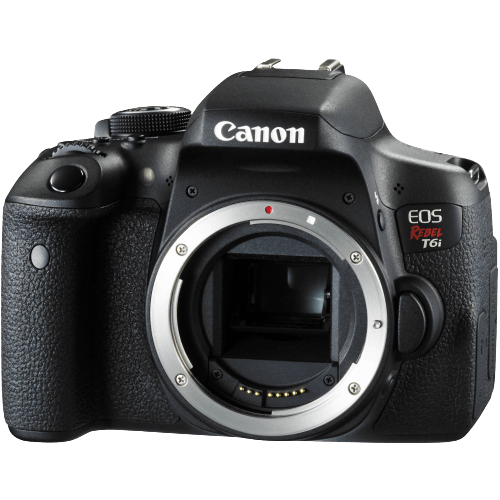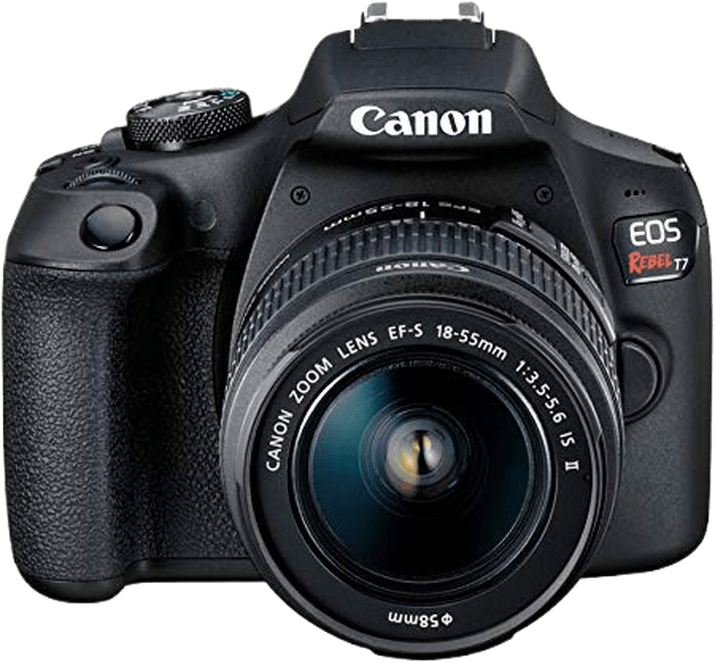Canon EOS Rebel T6i / 750D vs EOS Rebel T7 / 2000D Comparison
Canon EOS Rebel T6i / 750D

Canon EOS Rebel T7 / 2000D

The Canon EOS Rebel T6i / 750D emerges as the winner with a score of 56/100, compared to the Canon EOS Rebel T7 / 2000D‘s score of 50/100. Both cameras are DSLRs and have similar dimensions, with the T6i being slightly lighter at 555g. They were released in 2015 and 2018, respectively, with the T6i having a higher launch price of $750, while the T7 cost $550.
The T6i outperforms the T7 in certain specifications, which contributes to its higher score. On the other hand, the T7 has a lower launch price, making it a more affordable option for those on a budget. Despite this price difference, the T6i’s superior performance justifies its higher score and price.
Considering these factors, the Canon EOS Rebel T6i / 750D is the better choice for those seeking a higher-performing camera, while the Canon EOS Rebel T7 / 2000D might be suitable for budget-conscious buyers who can compromise on certain specifications.
Canon EOS Rebel T6i / 750D vs EOS Rebel T7 / 2000D Overview and Optics
The Canon EOS Rebel T6i / 750D emerges as the winner in terms of optics, scoring 59/100, while the Canon EOS Rebel T7 / 2000D trails slightly behind with a score of 56/100. Both cameras share several common specifications, such as a CMOS sensor type, a DXOMARK sensor score of 71, an APS-C sensor size, a Canon EF-S lens mount, and a lack of image stabilization.
The T6i / 750D outperforms the T7 / 2000D in a few key areas. Firstly, it has a slightly higher megapixel count of 24.2 compared to the T7’s 24.1, providing marginally better image resolution. Additionally, the T6i / 750D has a superior shooting speed of 5 frames per second (fps) compared to the T7 / 2000D’s 3 fps, allowing for faster continuous shooting and better capture of fast-moving subjects. Lastly, the T6i / 750D benefits from a more advanced processor, the Digic 6, as opposed to the T7 / 2000D’s Digic 4+ processor, which contributes to improved overall performance.
On the other hand, the T7 / 2000D does not have any significant advantages over the T6i / 750D in terms of optics. Both cameras have the same sensor size, lens mount, and lack of image stabilization, leaving the T7 / 2000D with no distinct edge in this comparison.
Considering these factors, the Canon EOS Rebel T6i / 750D is the better choice for those seeking superior optics performance. Its higher megapixel count, faster shooting speed, and more advanced processor give it the edge over the Canon EOS Rebel T7 / 2000D. The T7 / 2000D’s lack of notable advantages in optics makes it a less appealing option for photographers prioritizing image quality and performance.
Canon EOS Rebel T6i / 750D vs EOS Rebel T7 / 2000D Video Performance
The Canon EOS Rebel T6i / 750D and the Canon EOS Rebel T7 / 2000D both have a video score of 43/100. This means that their video capabilities are identical, and neither camera is superior to the other in this regard. Both cameras offer Full HD video resolution with maximum dimensions of 1920 x 1080 and a maximum video frame rate of 30fps. Additionally, neither camera has built-in time-lapse functionality.
Despite the identical scores, it is essential to examine the video capabilities of each camera. The Canon EOS Rebel T6i / 750D offers Full HD video resolution, which is suitable for most purposes, such as vlogging, home videos, and content creation. The 30fps maximum frame rate is standard for most entry-level DSLR cameras and provides smooth playback.
The Canon EOS Rebel T7 / 2000D also offers Full HD video resolution, which is suitable for most purposes, such as vlogging, home videos, and content creation. The 30fps maximum frame rate is standard for most entry-level DSLR cameras and provides smooth playback.
There are no significant differences between the two cameras in terms of video capabilities. Both cameras offer Full HD video resolution, a maximum frame rate of 30fps, and lack built-in time-lapse functionality. Therefore, when comparing the Canon EOS Rebel T6i / 750D and the Canon EOS Rebel T7 / 2000D based on their video capabilities, it is clear that there is no winner, as both cameras provide the same level of performance.
Canon EOS Rebel T6i / 750D vs EOS Rebel T7 / 2000D Features and Benefits
The Canon EOS Rebel T6i / 750D emerges as the winner with a feature score of 57/100, while the Canon EOS Rebel T7 / 2000D scores 41/100. Both cameras share several specifications, including a 3-inch screen size, flip screen, GPS absence, WIFI presence, and lack of Bluetooth.
The T6i / 750D excels with its higher screen resolution of 1,040,000 dots compared to the T7 / 2000D’s 920,000 dots. This difference allows for clearer image previews and better menu navigation. Furthermore, the T6i / 750D features a touchscreen, making it more user-friendly and efficient in selecting focus points and navigating settings.
On the other hand, the T7 / 2000D does not have any significant advantages over the T6i / 750D. Both cameras have the same screen size and flip screen, as well as similar connectivity options. The T7 / 2000D’s lower feature score reflects its lack of standout qualities.
To conclude, the Canon EOS Rebel T6i / 750D is the superior camera based on its higher feature score, better screen resolution, and touchscreen capabilities. The T7 / 2000D does not offer any considerable advantages over the T6i / 750D, making the latter a better choice for photographers seeking the best features in a Canon EOS Rebel camera.
Canon EOS Rebel T6i / 750D vs EOS Rebel T7 / 2000D Storage and Battery
The Canon EOS Rebel T7 / 2000D wins in the storage and battery category with a score of 27/100, compared to the Canon EOS Rebel T6i / 750D’s score of 24/100. Both cameras have one memory card slot and accept SD, SDHC, and SDXC memory cards. However, the T6i / 750D is compatible with UHS-I cards, while the T7 / 2000D is not.
The T7 / 2000D outperforms the T6i / 750D in battery life, providing 500 shots per charge compared to the T6i / 750D’s 440 shots. The T7 / 2000D uses an LP-E10 battery, while the T6i / 750D uses an LP-E17 battery. Neither camera offers USB charging.
The T6i / 750D has the advantage of UHS-I compatibility, allowing for faster data transfer speeds. However, the T7 / 2000D has a longer battery life, which is more beneficial for extended shooting sessions.
Considering these factors, the Canon EOS Rebel T7 / 2000D is the better choice for storage and battery performance due to its longer battery life, despite the T6i / 750D’s UHS-I compatibility.
Alternatives to the Canon EOS Rebel T6i / 750D and EOS Rebel T7 / 2000D
Are you still undecided about which camera is right for you? Have a look at these popular comparisons that feature the Canon EOS Rebel T6i / 750D or the Canon EOS Rebel T7 / 2000D:

